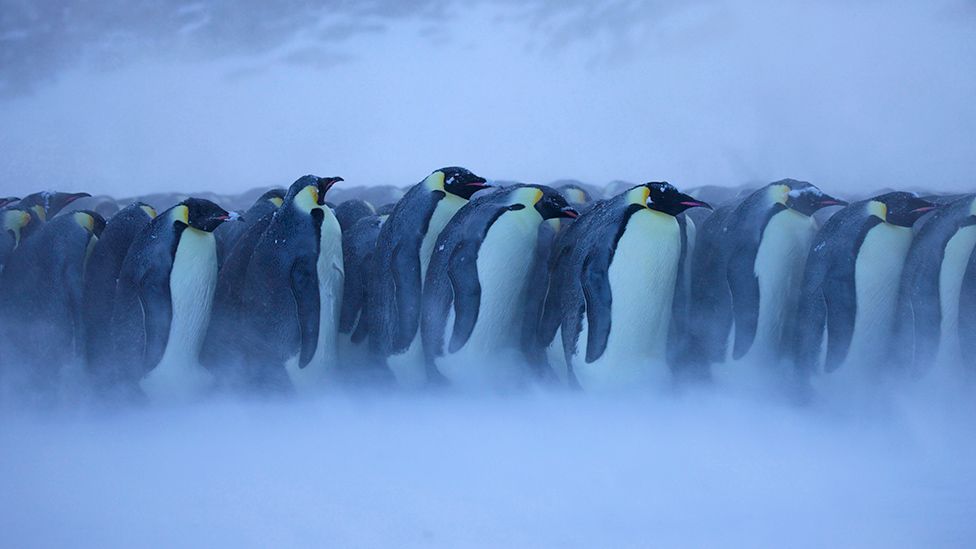Climate change: Four new emperor penguin groups found by satellite
- Published

Four new emperor penguin colonies have been identified in Antarctica from satellite imagery.
It brings the number of known nesting sites around the White Continent to 66.
With the discoveries, scientists believe they now know the whereabouts of all the world's remaining breeding pairs.
It's vital information for conservationists monitoring a species that's under increasing pressure as a result of climate change.
Emperors court, mate, lay and hatch eggs, and then bring up their young on the sea-ice connected to the coast - so-called fast ice.
But this type of ice has diminished in parts of Antarctica and become more variable, certainly in recent years, putting a big question mark against the long-term viability of the species in an ever-warming world.
Emperors are the largest species of penguin, standing at over 1m tall.
They live in extreme conditions, collecting together during the height of the Antarctic winter to breed in distinct groupings.
These colonies tend to be separated from each other by an average of about 250km (150 miles). Scientists have been using satellites to search the gaps in this spacing for birds they didn't know about - and think all significant colonies have now been identified.
The four new sites are welcome news, even though they add just a few thousand extra individuals to what's estimated to be an overall population of about 550,000.
"It's good that even as emperors are being affected by changing ice conditions, we're still finding colonies," said Dr Peter Fretwell from the British Antarctic Survey (BAS).
"But it's also clear these birds are going to have to be adaptable, to move around to new sites as those ice conditions continue to change, and we're seeing evidence of this," he told BBC News.
At least one of the newly identified colonies - named Lazarev North - is likely a grouping of birds that had to abandon a nearby site to take up a more favourable home.
The new Gipps colony, too, shows evidence in the satellite record of having shifted its position over time.
The two other locations, at Verleger Point and Vanhoeffen, appear to have had a more permanent history.
Vanhoeffen was probably missed in previous searches because it is 30km offshore, on fast ice that has developed around old icebergs which became stuck in shallow water.
Satellites have been the technique of choice for finding emperors. Antarctica's size and remoteness make observation from space the only practical approach.
The colonies are traced by the staining their guano ("poo") leaves on the white ice.
If the birds are gathered in large enough numbers, this staining will be visible even from space.
Dr Fretwell has identified about half the colonies we now know about.
He uses the EU's twin Sentinel-2 spacecraft. Their repeat imagery has, for example, allowed the BAS scientist to monitor the repeated attempts by emperors to re-establish a colony near Britain's Halley research station.
The colony, known as Halley Bay, was once the second largest in all Antarctica, but was wiped out in 2016 when sea-ice conditions suddenly changed.
Thousands of young emperors drowned or froze to death when the fast ice on which they were standing broke apart.
A pioneer group of birds has now set up a nesting site around a point that recently witnessed the calving of two monster icebergs.
"It just shows this is a species that has to be dynamic," said Dr Fretwell.
"When we do get future ice losses, emperors can and will move. It's in their nature."
The BAS scientist has not long returned from Antarctica where he's been tracking emperors with satellite tags.
This is providing new insights on the distances the birds will travel to forage for the food they need to bring back for their young at nesting sites.
The data shows the adults can travel over 100km (62 miles) a day.
The new penguin colonies are reported in the journal Antarctic Science.